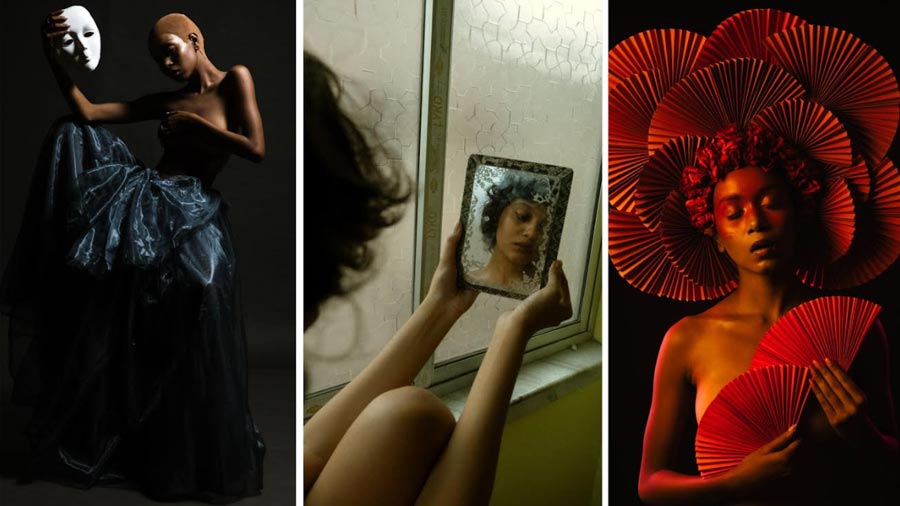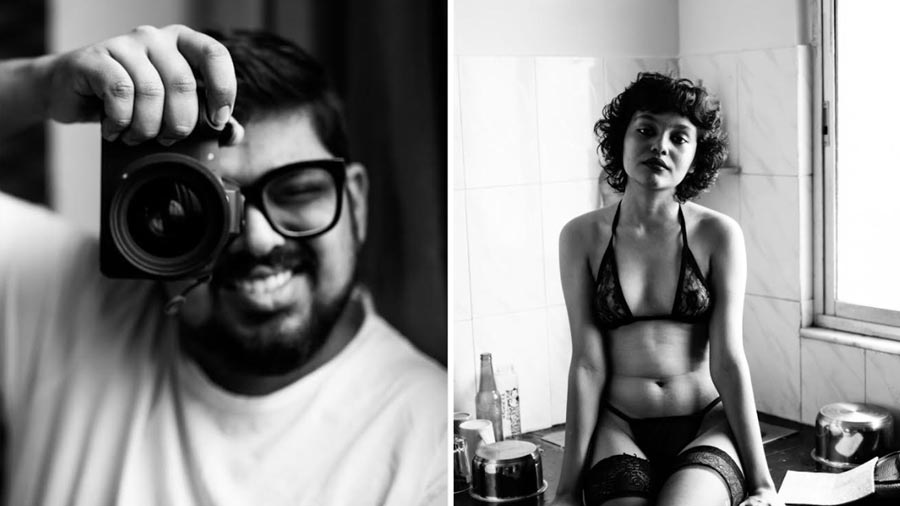On weekdays, Rikrivu Banerjee is just another 28-year-old engineer, working a 9-5 job. On Sundays, he’s scheduled like an artist. The nude art photographer, who has amassed more than 6,400 followers on Instagram, helps his audience re-think mainstream notions of beauty.
Banerjee has been in love with the art form for over 10 years now. He had his first tryst with photography when his father, an enthusiastic shutterbug himself, got him his first camera. “It was one of those old point-and-shoot cameras from Canon. I was 14 then and just saw it as a hobby. I had gone for a char dham trip and fell in love with photography,” he says.
While he started off with street photography and captured a lot of butterflies and bees as a teenager, his interest grew when he went to Bhubaneshwar for college and saved up for better gear. “I never learnt photography formally outside of watching YouTube videos. I just picked up a camera and started clicking,” he shares.
After a year in Bhubaneshwar, he moved to Kleve in Germany, to study at Hochschule Rhein-Waal. It was there that he got acquainted with nude art photography and discovered the liberation a camera offers, to capture emotions. “Instagram had just come up back then, and I used to follow a profile that would do nude body contortions. As a child, I always had severe body-image issues and wanted to feel good about my body. So, I started taking self-portraits. More than the pictures, I fell in love with the process of clicking them.”
He also started asking some of his close friends to model for him. Slowly word spread. “People began asking me if I would do shoots because they wanted to gift their partners a set of intimate pictures. That used to pay for my tuition in Germany.”
After he got done with his course, Banerjee returned to India and started working as an engineer, but hung up the camera. For a year, he was on a hiatus from nude art, as he wasn’t sure if it would be accepted in India. A chance meeting led him to pick up the camera again. “I met a friend who was equally passionate about nude art and she agreed to model for me. The pictures were very well received and I’ve been doing it ever since,” he says.
‘There has to be a story connected to each frame’
After dedicating a decade to the art form, he admits that his process is more refined now. “I started off with the idea of not editing anything, but just getting the raw output of how people are. The usual beauty standards in magazines are very superficial, creating this image of perfect bodies with zero figures and washboard abs. In this rut, it is refreshing for a picture to show you exactly how you are and still look appealing.” Banerjee adds that showcasing the body is much more artistic than just putting it out there. “There has to be a story connected to each frame,” he says.
In order to preserve this aesthetic, he does not constrain his shoots to a particular theme. Banerjee’s only requirement is that both the model and he himself should be at their most comfortable so that the pictures look natural.

“I get to know the model first and understand what their perspective is. There are people who want to do it because they need financial help or want to become professional models. The most important thing I need to know is how they feel about the art form. Everybody needs to be on the same page to give rise to the vision,” Banerjee points out.
‘No two expressions are ever the same’
Once there is a sense of comfort established, Banerjee follows an open-ended process. He gives the model an emotion like grief or happiness and asks them to emote it. He deliberately does not show them references. Even when he does create a mood board, it is purely to re-create and not to replicate. “I don’t just take one shot and wait. I like to keep clicking because I don’t want to miss the transitional moments. The part where you see their minds working while they process the cue is beautiful, and that is what I like to capture. No two expressions are ever the same,” Banerjee remarks.
The photographer also stays away from excessive input, which could make the shoot too mechanical. Banerjee recalls how he invested money into a shoot once but didn’t get quality pictures. He decided to sit down with the model, and they talked for four hours. This ice-breaking phase led to both parties understanding the vision better, and they got beautiful pictures within the next hour. “You need to be open-minded to get pictures out of any situation. In nude art, it is very important to put your co-creators at ease, just like in any other art form.”
Tricky relationship with Instagram
A shoot entails more than just clicking and posing. There’s a whole lot of visual and aesthetic intervention involved. “A shoot is not just six pictures. I click around 1000 pictures out of which I shortlist 200. I end up sorting and editing close to 40, and post maybe 2 or 3. There’s a long selection process.”
Banerjee is aware of how someone may perceive his art quite differently from him and tries to encourage people to derive their own meanings. “Earlier, I would give long captions, but I got one feedback that said that writing a story for the picture limits the scope of interpreting it differently. While I have ice cream when I am happy, someone might have it when they are sad. From that point, I started giving cues of words which popped into my mind when I shot that picture. I like leaving it to the audience to interpret.”
His relationship with Instagram has been tricky. His current page @nuancedart is his third profile; his first two pages had been taken down by the platform after notching 32,000 and 18,000 followers respectively. And yet, he is committed to building this profile, in an effort to normalise nudity and legitimise the art form.
‘I’m not putting up a superficial show’
Banerjee tries to translate his openness with his subjects to his Instagram audience. When it comes to pictures, he doesn’t retouch a photo for more than two or three minutes. Even then, he does not use Photoshop, only Lightroom. “Sometimes there are people who don’t want bodily scars in their pictures, but I personally think they can help because it makes the whole thing more real. I’m not putting up a superficial show. There is no manipulation of the body,” he breaks down.
One of the reasons why his accounts have been taken down is Instagram’s increasingly stringent censorship. Banerjee recounts how the platform was much more tolerant of nude art when he started out. “There were obviously censorship issues and I had to blur nipples and private parts. Now, even if you show a sliver of a butt-crack they will take the picture down.”
Why then, does he keep at it? Banerjee refers to Instagram as ‘a platform where you can put out art, and interact around it.’ He hopes that someday, Instagram’s warmth towards other art forms will extend to nude art too. “Sadly, only Reddit, Twitter and Behance allow nude art. But you can’t control content theft on Reddit, Twitter is more of an opinion-based platform, and Behance caters to professionals. My idea is to reach the masses so that I can show them that nudity is normal. I want people to realise that it is a person’s choice whether they want to share their body or physical self with anyone else.”
‘Somebody can be completely naked, without being sexual’
The photographer recounts how nude art photography evolved in India. When he started out, there were barely two or three profiles like his. “Even if people were doing it, they wouldn’t put their work out as there was a taboo around it. I built a niche for myself, where people would come up to me and want to be educated about nude art.”
Now, he sees many more people breaking through the stigma and showcasing their work. While he agrees that there is still an underlying stigma to it, Banerjee points towards rich aspects of Hindu culture where nudity has forever been prevalent. “There is a lot of nudity depicted on the walls of Khajuraho and the Konark Sun Temple. There is plenty of information in our scriptures about nudity, but somehow it has been connected to the sacredness of a woman’s modesty. Just because someone is nude, doesn’t mean they aren’t respectable.”
This issue goes deeper, with many people comparing nude art to pornography. “I’ve faced this problem where people landed up at the venue and said that I couldn’t do such a ‘dirty shoot’. I just want nude art to be on the spectrum where it is recognised as an art form.”
Another problematic perception reflects in his DMs, where people ask him if he develops a sexual desire for his models.
“When a doctor checks a patient or an engineer makes a graph, they don’t get turned on, right? I have a professional approach, which I don’t malign with pleasure. The whole process is liberating in itself, I don't need to sexualise it. It is very important for me to practice my art with the utmost honesty,” Banerjee shares.

‘Just because someone is nude, doesn’t mean they aren’t respectable,’ says Banerjee
He adds that this is his central fight, of drawing a parallel between nudity and desire. “Even in nude art, there are different genres. Erotica can exist without a person being naked. Similarly, somebody can be completely naked, without being sexual. Sexuality is amazing and meant to be explored, but not everything is inherently sexual.”
The challenges don’t end at perception though. He maintains that the biggest challenge is to get people to work with him. “It's a huge step for somebody to share their body. You need to have complete trust between the muse and the photographer. There should be clarity in the conversations and you need to make sure that your collaborator is at ease with your ideas.” He also warns photographers against persuasiveness. “You need to respect a ‘no’, and understand that it is not a ‘maybe’,” he says.
“I still struggle with body-image issues. When I do, I just take some pictures of myself and come to terms with it, because it is not somebody else's perspective. The camera doesn't lie,” the photographer says.
